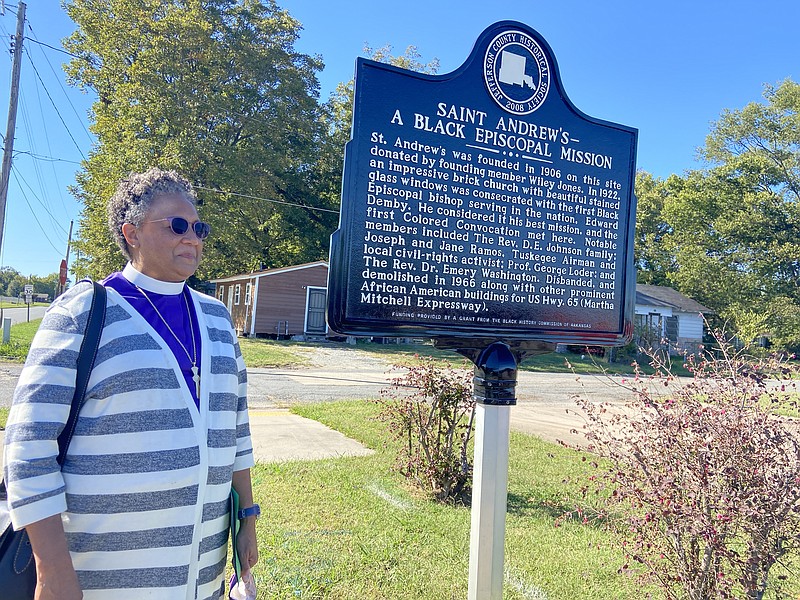St. Andrew's Episcopal Church was built at a time when Jim Crow laws forced race separation, enforced through cruelty, lynching and terror. More than 60 years later, the church was demolished in an attempt to destroy a prosperous Black neighborhood by running a highway through it.
That's how one Episcopal Church bishop and a retired professor described the events that shaped the former Black mission church, once standing at the corner of Pullen Avenue and Oak Street, at a Sunday afternoon dedication service of a historical marker.
Both the Rev. Phoebe Roaf, Episcopal bishop of West Tennessee, and Peter Perschbacher, retired University of Arkansas at Pine Bluff professor, talked about the church and its history.
The marker was made possible by Grace Episcopal Church and a $3,000 grant from the Black History Commission of Arkansas.
Pine Bluff Mayor Shirley Washington welcomed the group of about 30 to the 2:30 p.m. dedication.
Stephanie Fox, Grace Episcopal Church priest-in-charge, said: "It's most important that we acknowledge our history. Speaking truth is one of the first steps to healing the past and moving forward."
THE CHURCH
"In 1906, St. Andrew's was organized as an all-Black mission church under the auspices of Trinity Episcopal Church. The church was consecrated in 1922 by Bishop James Ridout Winchester," said Rick Williams, Grace Episcopal Church spokesman and parish administrator.
He researched St. Andrew's history prior to the dedication.
The church was built in 1906 and remained standing until 1968 on property donated by Wiley Jones, a highly successful Pine Bluff businessman and a founding member of St. Andrew's.
"He was one of the most successful Black men in Pine Bluff," and at one time, he was the richest Black man in the state, Williams said.
It served as one of seven a Black mission churches in Arkansas and was born out of the ministry of Rev. Robert Trimble, Rector of Trinity Episcopal Church of Pine Bluff, in 1866.
A mission church is an organized effort to spread Christianity to new converts. Missions such as St. Andrew's undertook evangelical, educational or healthcare efforts.
THE UGLY TRUTH
The church was long gone before the Roaf's family moved to Pine Bluff. Roaf is the first Black woman to serve as bishop to lead the West Tennessee diocese, the first in the South and the fifth in the Episcopal Church, and she was the guest speaker Sunday afternoon.
Roaf is the daughter of the late Clifton Roaf, a Pine Bluff dentist and community leader, and the late Andree Layton Roaf, the first Black woman to serve on the Arkansas Supreme Court.
For Black priests early last century, it was a struggle.
In the beginning, they often weren't paid or given free housing as their white counterparts were, and they couldn't even receive Holy Communion at the altar, she said.
"Many weren't seen as fully human," Roaf, said during her talk.
Perschbacher also spoke, saying the church was constructed during "different times."
It was built only about 40 years after slavery, and during a time when Jim Crow laws (about 1877 until 1950) ruled the South.
Roaf admits there are embarrassing aspects of the Episcopal Church but she spoke out of honesty. The church can't move forward with hope without intentionally examining its past, she said.
"We've made great strides. There's more work to be done," Roaf said.
The last service was held in St. Andrews on April 28, 1968.
It was demolished, making way for the Martha Mitchell Expressway.
The destruction of Black neighborhoods for highway projects happened in large and small towns across the country. Nearby examples also include Little Rock and North Little Rock with the construction of interstates 630 and 30 in the 1960s.
"This impacted and harmed entire communities," Fox said.
A PROFOUND GESTURE
Once St. Andrew's was destroyed, Black displaced members were welcomed at the Trinity Episcopal Church, 703 W. Third Ave., and at Grace Episcopal Church, 4101 S. Hazel St.
And that was a time when Black people couldn't sit at a downtown Pine Bluff lunch counter with white people, Perschbacher said.
For Cherie Robinson and Karen Huddleston, both Grace Episcopal Church white members, the day's brief history lesson and the church's part was enlightening.
"I'm glad we played such a pivotal role," Robinson said.
Frances Dalton, a Black Trinity Episcopal Church member, said she learned the good and the bad of the Episcopal Church on Sunday afternoon.
"People make the church. People make the change," she added.
WITH PURPOSE
"Really, it's a rededication," Williams said about the Sunday ceremony.
There was an original marker, but it was damaged beyond repair by an automobile years ago, and later, mysteriously disappeared.
Until Sunday, there was nothing to denote the spot where the church once stood except city park public restrooms and the Saracen Splash Park.
It's being done, William said, "to commemorate the history of St. Andrews and the importance it served to the city of Pine Bluff."
Williams added, "We want to make sure it remains a part of our history and people know about the part it played in our (Pine Bluff's) history."
Perschbacher, who led the effort to secure funding for the marker, said at the service, "These are different times...We've broken the bonds of slavery and Jim Crow but we need to establish the bonds of brotherhood, equity, respect and justice."


